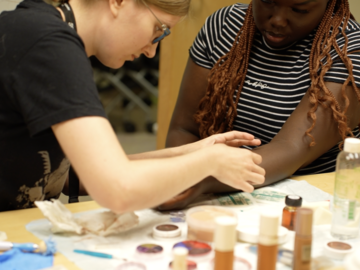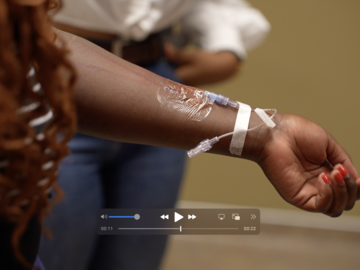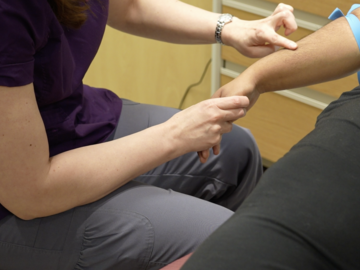Sept. 22, 2023
UCalgary nursing student creates inclusive guide for starting IVs

Everyone has the same anatomy, so why is that some groups of people are considered to be more difficult when it comes to starting IVs?
It is often said that it can be challenging to find a vein in people who have edema, obesity, are children or who have dark skin. But within clinical practice, nurses are usually taught how to start IVs — intravenous delivery of fluids — on patients with lighter skin.
With our ever-more-diverse communities, and with people of colour needing medical treatment every day just like anyone else, Tolu Adewole, a fourth-year nursing student at the University of Calgary, saw this gap as an opportunity to expand the nursing curriculum and prove that people of colour, in particular, are not necessarily difficult IV patients.
“We need to find a different way of starting IVs because I don’t think people should be discriminated against because of their skin tone. There is so much of focus on being able to see it (veins), but, if you can’t ‘visualize’ the vein, then what do?” says Adewole, referring to how nurses are generally taught to locate where to insert the IV.
“Do you call an experienced person, or should every nurse know how to do it? That was the idea for this project.”

PURE Award winner Tolu Adewole
Victoria Pizarro
With her passion and drive to help improve patient care and outcomes, Adewole, with the help of associate professor (teaching) Dr. Kara Sealock, BN’00, MEd’12, EdD’19, who is on the Equity Diversity, Inclusion and Accessibility Committee at the Faculty of Nursing, applied for the Program for Undergraduate Research Experience (PURE). PURE makes it possible for students to learn from on-campus experts about how research projects are developed, and how their results can contribute to new knowledge while solving problems in society.
Adewole was awarded funding for her IV project back in March, giving her and Sealock eight weeks from July to August to produce their project: a guide for students to learn how to feel veins and strategies to make a vein more visible.
“We have a lot of diversity in nursing as it is and our textbooks and our primary guides do not actually represent the populations that we serve, nor do the students actually see themselves in the textbooks with the materials that we use,” says Sealock. “In order to change that, we're starting it from a grassroots kind of approach in that, how do we make change?”
Adewole and Sealock began the process of creating a lab guide that is standardized, explaining every step in a way that allows all nursing students to see the exact same thing. With the help of the (TILT) and the Clinical Simulation Learning Centre (CSLC) at the Faculty of Nursing, Adewole gathered friends and other nursing students in a lab to produce images and video that will be included in the guide.

PURE mentor and associate professor Kara Sealock.
Victoria Pizarro
The volunteers for this project possess a range of skin tone that nursing students can expect to see within the community; this will ensure that future students have better learning opportunities and representation.
“We needed to make sure that we could see the venous system of people of colour; currently right now what exists is only light-skinned people in textbooks because it's easier to see what a blue vein looks like,” says Sealock. “So, in order to represent all the different people that we serve, we wanted to ensure that the pictures represented the venous system of people of colour, and that the action of starting IVs is not that different on anybody.”
With the help of the Technology Integrated Learning Team and the CSLC, Adewole and Sealock also aim to demonstrate what complications of IV therapy such as phlebitis — inflammation that causes a blood clot to form in a vein — would look like on people with darker skin. Moulage (makeup) helped the team show what irritation would look like on a patient of colour. Including these types of images in the guide is critical as these types of complications will present differently on darker skin tones, they say.
All the work to produce this guide will create a product and resource that will be valuable for students and educators in the long term. For Adewole and Sealock, this project was really about nurses helping nurses and they hope that soon this guide will be used not only at UCalgary, but also across Canada.
This is only the beginning for Adewole, who wants to keep moving into research and creating more guides for all different types of medical procedures, symptoms and complications — and what they look like for people of colour.
“If we can teach students what clinical manifestations look like on people with dark skin, (as) they become practitioners, they will hopefully be able to identify key signs early in the disease process that would lead to early interventions and, hopefully, better health outcomes for our patients. So I really hope that this project sheds light on the bigger problem,” says Adewole.










